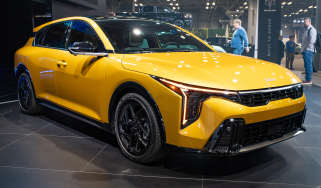Ford S-Max vs Ford Galaxy
Motoring editor and dad Dan Strong picks from blue oval brothers
Carrol Shelby, the man behind the Ford-engined AC Cobra, once said: “When it comes to cubic inches, too much is just enough...” Of course, he wasn’t considering the Strong clan’s quest for space on the move when he uttered those famous words – more the performance of his giant-killing sports car. Yet now that I’ve turned my back on high-performance models in favour of more child-friendly people carriers, cubic inches have never been more important.
And the interesting thing about space in a car is that if you have it, you tend to use it. I can’t remember the last time I left home with an empty boot. But does that mean I need more capacity? To find out, I traded my Ford S-MAX for the firm’s bigger Galaxy.
The two share the same platform, and are built side-by-side at the blue oval’s Genk plant in Belgium. Yet the Galaxy falls behind straight away when it comes to looks. It has a more boxy profile, and misses out on the sporty details that distinguish the S-MAX.
Of course, the advantage of the Galaxy’s shape is that there’s more headroom in the back – especially in the third row. I rarely use the rearmost seats in the S-MAX, though, and certainly wouldn’t subject grown-ups to the experience. Those in the Galaxy are better, although they’re still not what you’d describe as spacious.
Used - available now

2022 Nissan
Micra
22,169 milesManualPetrol1.0L
Cash £10,700
2015 Volvo
S60
78,200 milesManualPetrol1.6L
Cash £7,400
2016 Tesla
Model S
78,000 milesAutomaticElectric
Cash £18,999
2019 Nissan
Micra
17,450 milesAutomaticPetrol1.0L
Cash £13,199You’d expect the load area to be the main battleground for the Ford duo. The Galaxy is 52mm longer than the S-MAX, at 4,820mm; add the height advantage, and the former has a maximum capacity of 2,325 litres – that’s 325 litres more. Yet the difference is negated with the third row of seats in place, as the Galaxy offers only 23 litres extra.
I’m sure I would fill the extra boot room, but I’m not convinced it would be terribly useful – especially when the Galaxy’s larger dimensions have such a major bearing on its driving dynamics. While the two are equally composed on the motorway, around town the Galaxy is more of a challenge to drive and a lot harder to park. It has more of an MPV feel than the driver-focused S-MAX.
There’s also an image issue: the bigger Ford makes me look like a taxi driver. An upmarket one, admittedly, but the point is it doesn’t convey the same lifestyle message as the S-MAX. Fuel economy is another sticking point. Even though both cars are fitted with Ford’s excellent 2.0-litre TDCi diesel, the Galaxy is heavier and has an auto gearbox, so in my hands it returned 38.1mpg to the manual S-MAX’s 44.1mpg.
Still, there is plenty to like about the Galaxy. The ride quality is excellent, and our car is fitted with the IVDC active suspension system, which enhances it further. Our long-term S-MAX features standard springs, and can be a little fidgety in comparison.
The Galaxy is also incredibly practical, thanks to its overhead storage bins. As in the S-MAX, folding the rear seats down is a very simple process. My only criticism of the passenger area is the flimsy parcel shelf – it’s tricky to fit, and once removed there’s no dedicated place in which to store it. This seems a big oversight in a car designed for family living and load-lugging.
Ultimately, both cars are excellent people carriers, but one clearly stands out for me. Although it could do with more cubbyholes up front, and I’m not a particular fan of the electric handbrake, in every other respect, the S-MAX is a superb car. The Galaxy is just too boxy, and can’t match its brother in the image stakes. And the deal breaker from my point of view is the price difference.
Would I trade up?
NO. You pay £3,000 more to buy the Galaxy, and the increase in space over the S-MAX simply isn’t big enough to justify this.







